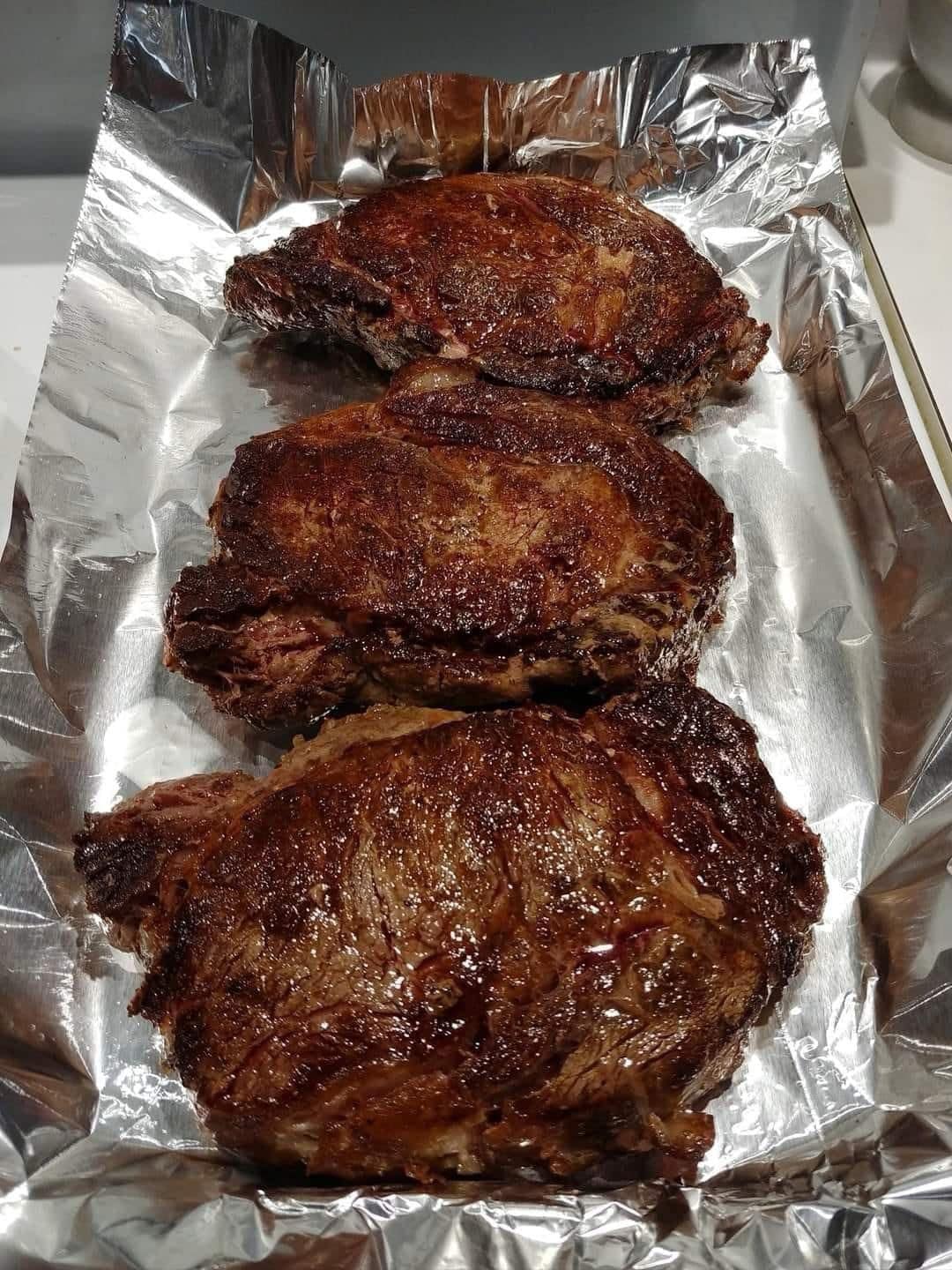ADVERTISEMENT
#### Instructions for Pan-Searing:
1. **Preheat the Pan:** Place a cast-iron skillet or heavy-bottomed pan over medium-high heat and add a tablespoon of vegetable oil or butter.
2. **Season the Steak:** While the pan is heating, season your ribeye with salt, pepper, and your choice of herbs and spices.
3. **Sear the Steak:** Once the oil is shimmering, place the ribeye in the skillet. Sear for about 4 minutes per side for medium-rare, depending on the thickness of the steak.
4. **Baste with Butter (Optional):** For an extra indulgent steak, you can add butter, garlic, and herbs (such as thyme or rosemary) to the pan during the last minute of cooking and baste the steak.
5. **Rest the Steak:** After cooking, let the steak rest for a few minutes before slicing.
### 3. **Broiling Ribeye Steak**
Broiling is another excellent method for cooking ribeye steaks. This method uses high, direct heat from above to sear the steak, similar to grilling.
#### Instructions for Broiling:
1. **Preheat the Broiler:** Set your oven’s broiler to high heat. Position the oven rack so that the steak will be about 4-5 inches from the broiler element.
2. **Season the Steak:** Season your ribeye steak with salt, pepper, and any desired spices.
3. **Broil the Steak:** Place the steak on a broiling pan or a rack set over a baking sheet. Broil for 4 to 5 minutes per side for medium-rare. Keep an eye on it to avoid overcooking.
4. **Rest the Steak:** Let the steak rest for 5 minutes before serving.
### 4. **Reverse Searing Ribeye Steak**
Reverse searing is a method that involves cooking the steak at a low temperature in the oven first and then searing it in a hot pan. This method results in a beautifully cooked steak with a perfect crust.
#### Instructions for Reverse Searing:
1. **Preheat the Oven:** Preheat your oven to 275°F (135°C).
2. **Season the Steak:** Season the ribeye with salt, pepper, and any additional herbs or spices.
3. **Cook in the Oven:** Place the ribeye on a wire rack over a baking sheet. Cook in the oven for about 20-30 minutes, depending on the thickness of the steak, until it reaches an internal temperature of around 120°F for medium-rare.
4. **Sear the Steak:** Heat a pan with a little oil or butter over high heat. Sear the ribeye for 1-2 minutes per side to develop a nice crust.
5. **Rest the Steak:** Let the steak rest for a few minutes before serving.
## Ribeye Steak Doneness Levels
The perfect doneness for ribeye steak is ultimately a matter of personal preference. Here are the general guidelines for cooking your steak to various levels of doneness:
– **Rare (120-125°F):** Cool red center, very soft and tender.
– **Medium Rare (130-135°F):** Warm red center, juicy and tender.
– **Medium (140-145°F):** Pink center with a slightly firmer texture.
– **Medium Well (150-155°F):** Slightly pink center, firmer texture.
– **Well Done (160°F and above):** Little to no pink, firm and less juicy.
The best way to check for doneness is by using a meat thermometer inserted into the thickest part of the steak.
## Ribeye Steak Pairings and Sides
To elevate your ribeye steak experience, consider serving it with complementary sides that will balance the richness of the steak.
### 1. **Garlic Mashed Potatoes**
Rich, creamy mashed potatoes are a classic side dish that pairs perfectly with ribeye steak. The creaminess complements the steak’s bold flavor, and the garlic adds a savory touch.
### 2. **Grilled Vegetables**
Grilled vegetables, such as asparagus, zucchini, and bell peppers, add freshness and balance to the rich, fatty ribeye steak.
### 3. **Sauteed Mushrooms**
Mushrooms are a natural pairing for beef. Their earthy flavor and meaty texture make them an excellent side dish for ribeye steak.
### 4. **Caesar Salad**
A crisp, tangy Caesar salad provides a refreshing contrast to the richness of the steak. The crunchy lettuce and creamy dressing add texture and flavor to the meal.
### 5. **Red Wine**
A glass of full-bodied red wine, such as Cabernet Sauvignon or Malbec, enhances the flavor of ribeye steak. The tannins in red wine complement the steak’s fattiness, while the wine’s fruity and oaky notes elevate the overall dining experience.
## Conclusion
Ribeye steak is one of the most flavorful and versatile cuts of beef available. Whether you prefer grilling, pan-searing, or broiling, this cut consistently delivers a juicy, tender, and indulgent dining experience. By selecting the right steak, using proper cooking techniques, and pairing it with complementary sides and wines, you can create a memorable meal that’s sure to impress.
